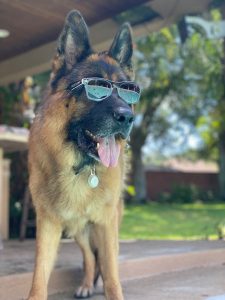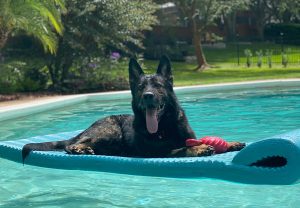Working and training with your dog is a fun and exhilarating experience for both the dog and the trainer. The use of positive reinforcement for training is the go-to method for Canine Extreme. When training with positive reinforcement, it’s essential to know what “drives” are and how you can utilize them to aid in your dog’s training. The term “drive” can be generalized as an instinct that coaxes the dog into performing a specific behavior. A great example of this would be the use of a ball on a rope to gain the attention and excitement of a puppy. With an accurate understanding of a few critical drives, we can employ them to make positive reinforcement training a fun, practical, exciting, and overall enjoyable experience for both the dog and trainer.
Staying Cool In The Heat
 Nothing says summer like sand between the paws, ice water by the pool, and walks in the sunshine. Summer is a time full of fun, adventures, and outdoor activities. While we all know how “cool” our dogs like to look over summer, like Kongo does while rocking his summer shades by the pool, it’s essential to remember to keep our dogs “cool” from the heat as well. Rest assured, while overheating and heatstroke are severe, with a bit of education and awareness of ways to keep cool, you and your pet can continue to enjoy all the fun activities that summer has to offer.
Nothing says summer like sand between the paws, ice water by the pool, and walks in the sunshine. Summer is a time full of fun, adventures, and outdoor activities. While we all know how “cool” our dogs like to look over summer, like Kongo does while rocking his summer shades by the pool, it’s essential to remember to keep our dogs “cool” from the heat as well. Rest assured, while overheating and heatstroke are severe, with a bit of education and awareness of ways to keep cool, you and your pet can continue to enjoy all the fun activities that summer has to offer.
Keeping your pet cool and cooling down your pet during the heat is an excellent skill to learn. While the most common answer to keeping your dog cool during the summer is to keep them inside in the AC, there are times where we still need to head outside with them. If you are adventuring outdoors during the heat, make sure to bring water for your dog to drink, look for shaded areas, and try to avoid the heat of the day. Some dogs love the water, and adding a small kid pool to your yard can be a fun way for your dog to play outside and keep cool. In addition, the water on the outside of the coat will help cool the dog down and prevent them from overheating. If you do not like your dog to be in the water, you can use a cooling vest to help keep their temperature down.
 The most common misconception about cooling down an overheated dog is to give them a bunch of water or to let them drink the water while they are swimming. While giving dogs water and keeping them hydrated is a significant factor, it’s also vital to monitor their water intake when they are overheated. When a dog is hot, they tend to drink water quickly and in excess, which can lead to bloat or water intoxication. You can take steps to prevent this by monitoring your dog while they drink and play in the water. Then, as the dog is cooling down, you can monitor their breathing and fatigue and slowly give them bits of water to help them cool down and stay hydrated.
The most common misconception about cooling down an overheated dog is to give them a bunch of water or to let them drink the water while they are swimming. While giving dogs water and keeping them hydrated is a significant factor, it’s also vital to monitor their water intake when they are overheated. When a dog is hot, they tend to drink water quickly and in excess, which can lead to bloat or water intoxication. You can take steps to prevent this by monitoring your dog while they drink and play in the water. Then, as the dog is cooling down, you can monitor their breathing and fatigue and slowly give them bits of water to help them cool down and stay hydrated.
Another important factor to consider when walking your dog is not only the temperature outside but the humidity and temperature of the ground. A common factor usually overlooked is the temperature of the ground, cement, and pavement that the dogs walk on. Remember, dogs do not have shoes like we do and can quickly burn their paw pads. A simple way to check for this is to place your hand on the floor. If the floor is too hot for you to keep your hand on it, it will be too hot for a long walk with your pup. If you’re going out for a walk on a hot day, looking into boots and pad waxes to add an extra layer of protection is a great idea!
Every dog is different and it’s essential to take preventive steps to keep them cool and understand their limits. If you believe that your dog is experiencing heat exhaustion, it’s best to seek a veterinarian’s attention as it can be life-threatening. Below you will find general signs and symptoms of a dog who is overheating and ways to prevent heat exhaustion.
Signs of heat exhaustion
- Excessive panting or difficulty breathing
- Excessive drooling
- Elevated heart rate
- Discolored gums: bright red, grey, purple, or bluish
- Dehydration
- Vomiting or diarrhea
- Seizures or muscle tremors
- Fever
- Collapse
How to prevent heat exhaustion and keep your pet cool
- Take walks in the early morning or late in the evening
- Try to walk and rest in the shade
- Stay on the grass or use a pad wax to prevent from burning their paws
- Bring water on the walk for the dog
- Use a cooling vest or a cold cloth
- Never leave your dog in an unattended car
- Know your pet’s limits and keep outdoor activities to a minimum on hot days
- Wetting the coat with cool water
More Articles
Common Titles and Abbreviations for German Shepherds
While researching and looking into a German Shepherd pedigree, you will see that titles and abbreviations are often used. When it comes to understanding the pedigree of the dog and their parent’s pedigree, it’s important to know what these titles and abbreviations stand for. There are countless ones out there. However, there are a few that show up more often than others. Below you can find a list of some of the more common titles and abbreviations that will be connected to your German Shepherd and their parents.
Grooming for German Shepherds
When it comes to owning a German shepherd dog, one factor that we all know is that they have thick beautiful coats. With this thick coat comes some upkeep that needs to be done on our end as owners. A common question that we at Canine Extreme get is; what combs and brushes do I use? While this can be based on preference, there are a few standard brushes that will benefit your furry friend. In this article, you will find a brief breakdown of some of the grooming needs that your German Shepherd dog has.